

The brokerage industry continued to contract last year, with the number of registered representatives overseen by the Financial Industry Regulatory Authority Inc. declining to 612,457, down from 617,531 at the end of 2020, according to the 2022 Finra Industry Snapshot.
The population of registered reps has declined every year since the broker-dealer self-regulator began publishing its Industry Snapshot in 2018; the 2021 total of 612,457 is down 2.8% from the 630,235 reps Finra reported for 2017.
The number of firms registered with Finra at the end of last year totaled 3,394, down from 3,345 at the end of 2020 and from the 3,726 firms registered with Finra in 2017. According to the data, that change occurred as 150 firms left the industry and just 109 firms entered.
While the number of B-Ds may be shrinking, their revenue continues to rise. Aggregate revenue for Finra-registered firms totaled $398.5 billion in 2021, up from $361.9 billion in 2020. Aggregate expenses in 2021 were $306.8 billion, resulting in a pretax income of $91.7 billion.

The alts giant's latest executive hire builds on its continuing strategy to expand into the private wealth space.

While it's a useful rule of thumb, wealth industry experts agree Social Security benefits, retirement income planning, and individual expenses should also be factored in.

The holdout optimist from Wells Fargo sees market "past peak uncertainty" as trade war fears push many cheerleaders to pare back their predictions.

Last year's standout winners reflect on their triumph as the wealth industry gears up for another unforgettable night in New York City.

Financial advisors are becoming a bit more leery that fees, particularly for their wealthiest clients, are on the verge of taking a hit.
From direct lending to asset-based finance to commercial real estate debt.
RIAs face rising regulatory pressure in 2025. Forward-looking firms are responding with embedded technology, not more paperwork.
